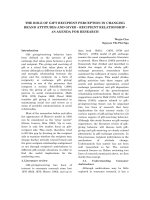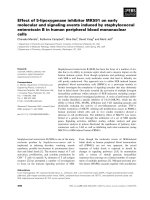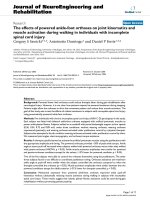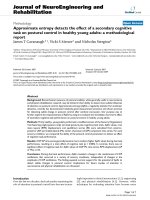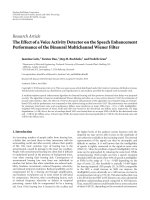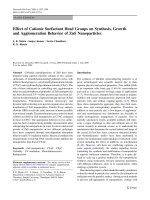The effect of some marketing mix elements on brand awareness and brank image
Bạn đang xem bản rút gọn của tài liệu. Xem và tải ngay bản đầy đủ của tài liệu tại đây (508.69 KB, 74 trang )
MINISTRY OF EDUCATION AND TRAINING
UNIVERSITY OF ECONOMICS HO CHI MINH CITY
----oOo-------
DIỆP THỊ PHƯƠNG THẢO
THE EFFECT SOME MARKETING
MIX ELEMENTS ON BRAND
AWARENESS AND BRANK IMAGE
MAJOR: BUSINESS ADMINISTRATION
MAJOR CODE: 60.34.05
MASTER THESIS
INSTRUCTOR: DR. TRAN HA MINH QUAN
Ho Chi Minh City – 2011
I
ACKNOWLEDGEMENT
This thesis is dedicated to my family, friends, professors and classmates for their
support and encouragement throughout my academic career. Recently, these people
have touched my life in many different ways.
First and foremost, I would like to give special thanks to Dr. Tran Ha Minh Quan
for being an excellent professor, advisor, thesis committee chair, and mentor. I
appreciate all the insight and time he put into helping me with my thesis. I am also
grateful to him for teaching me the basics, and advancing my knowledge and
expertise. I’d like to thank Dang Huu Phuc, who helped me in the data analysis.
Many thanks my professors and classmates in MBA class, Batch 17 for their
valuable and enthusiastic support for this research study.
My special gratitude is extended to all instructors, staff and students at Faculty of
Business Administration, University of Technology HoChiMinh City
(HUTECH) for their support and the valuable knowledge during my study.
Last but not least, the deepest and most sincere gratitude go to my beloved
parents, my husband, my daughter and my closest friends for their boundless
support, abundant love and encouragement throughout my period of study.
I,therefore, dedicate this work as a gift to them all.
II
ABSTRACT
The marketing effort orientated to towards strengthening the brand means to
increase the degree of knowledge of the brand name. In this paper we want to show
the relationship between marketing effort and brand awareness and brand image.
Starting out from a theoretical review, we set out a model of effects of the
marketing effort -as the brand's antecedents- on brand awareness and
brand image. In order to test the defined structural model and research hypotheses
empirical research was conducted on the sample of undergraduate students of the
Faculty of Business Administration in University of Techonology.
The structural model of the effects of marketing mix elements on brand equity is
defined in line with the existing theoretical findings. Research hypotheses are
defined according to the identified structural model. Research results indicate that
the structural model has an acceptable level of fit to the empirical data. The
estimated structural coefficients and indirect effect coefficients indicate the
direction and intensity of effects of each analysed element of marketing mix on
brand awareness and brand image. Finally, implications of research results for the
theory and practice of brand management are analysed and discussed.
KEY WORDS: Brand Image, Brand Awareness, marketing effort, Measurement
Model.
III
TABLE OF CONTENTS
ACKNOWLEDGEMENT....................................................................................... I
ABSTRACT........................................................................................................... II
TABLE OF CONTENTS ......................................................................................III
LIST OF FIGURES................................................................................................ V
LIST OF TABLES ................................................................................................VI
1 Chapter1 : Introduction ........................................................................................1
1.1
1.2
1.3
1.4
1.5
1.6
1.7
Introduction............................................................................................................ 1
Research Background ........................................................................................... 1
Research Motives.................................................................................................. 3
Problem statement................................................................................................. 4
Research Ojective................................................................................................. 4
Research methodology and design....................................................................... 5
Research Procedure .............................................................................................. 6
2 Chapter 2 : Literature review ...............................................................................7
2.1
Introduction............................................................................................................ 7
2.2
Brand ..................................................................................................................... 7
2.2.1
Brand Awareness .......................................................................................... 9
2.2.2
Brand image ................................................................................................ 11
2.3
Marketing efforts................................................................................................. 13
2.3.1
Advertising .................................................................................................. 13
2.3.2
Distribution intensity................................................................................... 14
2.3.3
Store image ................................................................................................. 15
2.3.4
Price deals ................................................................................................... 16
2.4
Relationship between marketing effort and brand awareness
and brand image .............................................................................................................. 17
2.5
Conclusion ........................................................................................................... 21
3 Chapter 3 : Methodology ...................................................................................22
3.1
Introduction.......................................................................................................... 22
3.2
Research design .................................................................................................. 23
3.3
Item generation ................................................................................................... 25
3.3.1
Introduction.................................................................................................. 25
3.3.2
Operationalization of measures.................................................................. 25
3.4
Preliminary study ................................................................................................ 29
3.5
Main survey......................................................................................................... 32
3.5.1
Brand selection............................................................................................ 32
3.5.2
Sampling ...................................................................................................... 32
IV
3.6
Conclusion ........................................................................................................... 33
4 Chapter 4 : Research results ...............................................................................34
4.1
Introduction.......................................................................................................... 34
4.2
Descriptions of sample........................................................................................ 34
4.3
Scales assessment ............................................................................................... 36
4.3.1
Reliability testing ........................................................................................ 36
4.3.2
Exploratory factor analysis ......................................................................... 38
4.4
Testing the research model and the hypotheses ................................................ 42
4.4.1
Testing correlations between all constructs ............................................... 42
4.4.2
Testing research model............................................................................... 42
4.4.2.1 The relationship between marketing efforts and the brand awareness.42
4.4.2.2 The relationship between marketing efforts and the brand image. ...... 46
4.5
Testing the effect of brand awareness and brand image on the year in college:
49
4.6
Findings and conclusion ...................................................................................... 51
4.6.1
Findings ....................................................................................................... 51
4.6.2
Conclusion ................................................................................................... 51
5 Chapter 5 : Conclusions and implications ..........................................................53
5.1
Introduction.......................................................................................................... 53
5.2
Conclusions of the study ..................................................................................... 53
5.2.1
Summary of all hypotheses......................................................................... 53
5.2.2
Conclusions of the study ............................................................................. 54
5.3
Implications of the study ..................................................................................... 57
5.4
Limitations and recommendations for further research..................................... 58
List of References..................................................................................................60
Appendix 1 – Questionnaire (Vietnamese version) ................................................63
Appendix 2 - Descriptive Statistics of variables.....................................................67
V
LIST OF FIGURES
Figure 1-1 : Outline of chapter 1 .......................................................................................... 1
Figure 1-2 : Structure of the study ........................................................................................ 6
Figure 2-1 : The structure of Chapter 2 ................................................................................ 7
Figure 2-2 : Dimensions of Brand Knowledge, Keller (1993). ........................................... 9
Figure 2-3 : Model of effects of marketing efforts on brand awareness and brand image
............................................................................................................................................. 21
Figure 3-1 : Outline of chapter 3 ........................................................................................ 22
Figure 3-2 : Research process............................................................................................. 24
Figure 4-1 : Outline of chapter 4 ........................................................................................ 34
Figure 4-2 : Whether used motocycles............................................................................... 36
Figure 4-3 : Owning brand .................................................................................................. 36
Figure 4-4 : Relationships between perceived advertising spending, distribution intensity
and the brand awareness..................................................................................................... 42
Figure 4-5 : Results of model I ........................................................................................... 45
Figure 4-6 : Relationships between marketing efforts and brand image. ......................... 46
Figure 4-7 : Results of model II.......................................................................................... 48
Figure 4-8 : Adjusted the structural model of impact of marketing effort on brand
awareness and brand image................................................................................................ 52
Figure 5-1 : Outline of chapter 5 ........................................................................................ 53
VI
LIST OF TABLES
Table 3-1 : Measures of perceived advertising spending.................................................. 26
Table 3-2 : Measures of distribution intensity ................................................................... 27
Table 3-3 : Measures of brand image ................................................................................ 27
Table 3-4 : Measures of price deals ................................................................................... 28
Table 3-5 : Measures of brand image ................................................................................ 28
Table 3-6 : Measures of brand awareness ......................................................................... 29
Table 3-7 : The final questionnaire .................................................................................... 30
Table 4-1 : Sample characteristics...................................................................................... 35
Table 4-2 : Reliability of the measurement instrument..................................................... 37
Table 4-3 : Rotated component matrix............................................................................... 40
Table 4-4 : EFA result for individual measurement scales ............................................... 41
Table 4-5 : The correlations among the dimensions of brand equity................................ 43
Table 4-6 : The results of linear regression analysis_Model I.......................................... 44
Table 4-7 : Summary of hypotheses testing results (Model I) .......................................... 45
Table 4-8 : The results of linear regression analysis_Model II......................................... 46
Table 4-9 : Summary of hypotheses testing results (Model II) ......................................... 48
Table 4-10 : Multiple Comparisons .................................................................................... 50
Table 5-1 : Summary of hypotheses................................................................................... 54
1
1 Chapter1 : Introduction
1.1 Introduction
This chapter portrays general introduction for the current study with which research
background, research motives, research objectives, and research procedures are
provided as the rationale for this study. An introduction to the methodology to be
used and the scope of the study is also addressed in this chapter. At the end of the
chapter, the structure of this study is provided.
The Outline of this chapter is shown in figure 1.1
Figure 1-1 : Outline of chapter 1
1.1 Introduction
1.2 Research Background
1.3 Research Motives
1.4 Research Ojective
1.5 Research Procedure
1.2 Research Background
Kathman (2002) described the importance of brand building based on today’s
market situation. The author said that as the use of new media (e.g., internet), the
rate of transformation in marketplace, and the speed of globalization increase, the
role of branding becomes more important than any other season. Kathman added
that market fragmentation, product diversity, and short-life-cycle brands also show
the importance of building brand equity in the present market situation. The author
2
concluded that brand building is the only way to thrive their business in today’s
market situation. The author also added that, in these days, we have many
products and brands and the market is segmented so much that make it difficult for
the audience to recognize or recall the brand.
Studies on branding issue receive the great attention in marketing area in other
countries. The growing interest is reflected in the proliferating conferences, articles,
and press attention on branding, as well as the companies’ huge investments on this
area. Brands are powerful strategic weapons which, if handled correctly and
managed sensibly, can provide their owners with considerable rewards in terms of
market share growth and corporate profitability (Aaker, 1996).
Branding has always been crucial for anyone who wants to sell something to gain
credibility (Keller, 2003). Yet, the concept of a brand which represents the specifics
of a product or a company, like a name which describes the character of the person
it belongs to, is a new one in Vietnam. Most Vietnamese firms are small or medium
sized and have not dealt with problems related to the branding issue. The media had
not highlighted it until several Vietnamese brands were recently appropriated
overseas (VnExpress, 2002; VET, 2003).
The severe shortage of commodities in the late 1980s and early 1990s consolidated
manufacturer’s lack of awareness about branding, particularly bearing in mind the
low per capita income of Vietnamese people. But the mushrooming of new
producers and service suppliers and the arrival of foreign competitors has caused
things to change drastically. An abundance of goods and services of higher quality,
advanced technologies, and shorter product life spans have forced local businesses
to think seriously about building brands which can give them long term and
sustainable development (VET, 2003). Right now, building brands is a very
important issue in developing country as Vietnam, and it can be considered to be a
useful topic for conceptual development and managerial relevance.
In several studies, brand awareness and image are considered the most important
3
components of brand equity (Keller, 1993). However, only a few studies delved into
how these components are correlated with products or services.
1.3 Research Motives
To date, there have been a number of studies that have attempted to examine how
consumers think about, respond to, and classify brands within their minds. Branding
literature has provided theoretical perspectives to help marketers understand the
construct of brand.
Brand equity has become a hot topic for chief executives, accountants and
academics as it is tipped to join other critical measures of long-term business
performance. At the same time, the 'knowledge economy' is becoming an accepted
framework for management thinking, planning and organisation.
It is perhaps
surprising, therefore, that the designated marketing function in so many companies
has done so little to advance the management of one of their most value-adding
activities - brand knowledge.
Indeed, it is nearly 40 years since Theodore Levitt pointed out the unique
perspective of marketing: "The difference between marketing and selling is more
than semantic. Selling focuses on the needs of the seller, marketing on the needs of
the buyer. Selling is preoccupied with the seller's need to convert the product into
cash, marketing with the idea of satisfying the needs of the customer by means of
the product and the whole cluster of things associated with creating, delivering, and
finally consuming it.” During those four decades, marketing departments have
grown as substantially as their budgets, huge quantities of data swamp the brand
teams and yet the evidence suggests they have not strengthened their grip on
'knowing and understanding' their users better. Over the same period the reputation
of the marketing function has declined in many companies.
4
1.4 Problem statement
Based on the importance of brand awareness and brand image to the company’s
surviving, we manage to investigate to what extent the students know about the
brand of motocyces (brand awareness) and what kinds perception of the brand of
motocycles as reflected by the brand association held in target customers’
memory (brand image).
1.5 Research Ojective
The aim of this paper is to find out the effect of the marketing effort, measured by
means of the perceptions of the consumers, on two dimensions of brand equity:
brand awareness and brand image. This paper is included within a major
investigation that seeks to develop and to contrast a model which allows the
measurement of the brand equity through: the influence of the marketing effort of
the companies (measured by means of actions of prices, product, distribution and
communication) on dimensions of brand equity -brand awareness and brand image.
The marketing effort, translated partially to (1) perceived advertising spending, (2)
distribution intensity, (3) store image and (4) Price deals , is considered as (a)
antecedent in the formation of the level of knowledge of the brand name (Rossiter
& Percy, 1987; Aaker, 1991) and (b) determinant of the associations linked to its
image (Alba & Hutchinson, 1987; Yoo, Donthu & Lee, 2000).
From the theoretical review on brand value we construct a theoretical model of
causal relationships between the marketing efforts and the dimensions of brand
equity_ brand awareness and brand image. This is defined as a set of assets and
liabilities linked to the brand, which adds or subtracts value to or from a product in
its relationships with customers (Aaker, 1991). To contrast the model, the linear
regression model is applied.
5
Following, Yoo et al. (2000), we analyse how each of the components of brand
equity is affected previously by the perception of the market about the marketing
effort the company develops concerning brands.
To verify our model we carry out an empirical research of a consumers' sample of a
durable goods (motocycle) which we submitted to a questionnaire of attitudes. Once
its reliability and validity was determined, this questionnaire could be used for the
application of the structural model.
To serve this task, two questions need to be answered:
Q1:Is there a relationship between marketing effort and two dimensions of brand
equity: brand awareness and brand image?
Q2: Is there any difference of brand awareness and brand image among year in
college?
1.6 Research methodology and design
The study comprises two phases: The pilot study and the main survey. The Pilot
study includes qualitative and quantitative stages. Qualitative stage was conducted
to collect the appropriate response scheme from students at University of
Technology. These items will be measured in the pilot quantitative study for their
relevance and reliability. Finally, the main survey was carried out to test the
research hypotheses, answer research questions and fulfill research objectives
Cronbach alpha was used to measure the reliability of the scale, exploratory factor
analysis was applied to identified correct factors and multiple linear regression was
performed to test the significant relationship between each marketing elements
dimension on brand awarenss and brand image.
6
1.7 Research Procedure
The procedures of this study are shown in figure 1
Figure 1-2 : Structure of the study
Identifying Research Objectives
Collecting and Exploring Related Literature
Establishing Research Framework
Questionnaire Design
Data Collection
Data Analysis
Conclusions and Suggestions
7
2 Chapter 2 : Literature review
2.1 Introduction
The previous chapter introduces an overview of the study background, the research
objective and the research motives and research procedure. This chapter searches
and reviews relevant theories in the literature. The aim of this review is to propose a
research model of marketing efforts and brand awareness and brand image, to
generate hypotheses that will be tested in chosing motocycles of the students to
answer the research questions and to confirm the research model.
Figure 2-1 : The structure of Chapter 2
2.1 Introduction
2.2 Brand
2.3 Marketing efforts
2.4 Relationship between marketing mix
and brand awareness and brand image
2.5 Conclusion
2.2 Brand
Brands can be defined as a “name, symbol, term, or sign that are intended to
identify the goods and services of one particular firm” (Kotler, 1991, p. 442).
Consumers’ consumption choices are often based on brand names that help to
8
differentiate one product from another. Branding researchers have tried to
conceptualize the value of a brand or brand equity (Faircloth et al., 2001). In the
general sense, brand equity can be defined as the “marketing effects that are
uniquely attributable to the brand” (Keller, 1993, p. 1). In other words, because of
the product or service’s brand name, different outcomes may result from the same
marketing activity (Keller, 1993).
Customer-based brand equity is centered on the idea of how a consumer’s
knowledge of the brand affects the consumer’s response to the brand’s marketing
activity (Aaker, 1991; Keller, 1993). From the perspective of the Customer-based
Brand Equity model, brand knowledge is the key to creating brand equity, because
it creates the differential effect that drives brand equity. What marketers need, then,
is an insightful way to represent how brand knowledge exists in consumer memory.
An influential model of memory developed by psychologists is helpful in that
regard. The associative network memory model views memory as a network of
nodes and links, in which nodes represent stored information or concepts and links
represent the strength of association between this information or concepts. Any type
of information can be stored in the memory network, including information that is
verbal, visual, abstract or contextual in nature. Consistent with the associative
network memory model, brand knowledge is conceptualized here as consisting of a
brand node in memory with a variety of associations linked to it. In particular,
Keller (1993) suggests that brand knowledge consists of two components - brand
awareness and brand image – which are discussed in detail in the next two sections.
9
Figure 2-2 : Dimensions of Brand Knowledge, Keller (1993).
Brand
Knowledge
Brand
Image
Uniquess of
Brand
Associations
Favourability
Brand
Awareness
Strength of
Brand
Associations
of Brand
Associations
Attribute
None
Product
Related
Product
Related
Types of
Brand
Associations
Benefits
Brand
Recognition
Brand
Recall
Attitudes
Functional
Experiential
Packaging
Price
User
Imagery
Usage
Imagery
Symbolic
2.2.1 Brand Awareness
The ease and likelihood to which a brand name comes to mind describes the
concept of brand awareness (Keller, 1993). Brand awareness reflects the strength of
a brand’s presence in the consumer’s minds (Pappu, Quester, & Cooksey, 2005),
10
and it is related to the strength of the brand node or trace in memory in relation to
the consumer’s ability to identify the brand in various conditions (Rossiter & Percy,
1987). Brand awareness can be demonstrated in the forms of brand recall and brand
recognition (Keller, 1993). Brand recall occurs when the brand name is evoked by
memory in response to a cue such as a product category name (Hutchinson &
Raman, 1994). Distinguishable from brand recall, brand recognition can be
conceptualized as the consumer’s ability to verify previous exposure to the brand
when the brand is given as a cue (Keller, 1993). In other words, brand recognition
occurs when the consumer is exposed to the brand and is able to identify it as being
seen or heard previously (Hutchinson & Raman, 1994; Keller, 1993).
Researchers have considered recall as a higher level of memory performance than
recognition (Aaker, 1991, Washburn & Plank, 2002). In other words, if a consumer
is able to recall a brand outside a store when given the product category as a cue,
then the consumer surely can recognize the brand when exposed to it in a store
(Keller, 1993, Rossiter & Percy, 1987).
Aaker (1991) explains brand awareness as having many levels ranging from
recognition (being identified as seen or heard previously) at the lowest level, to
brand recall (being evoked in a response to a cue such as product category) at mid
level, to the highest level, the dominant brand or the only brand that can be recalled
by a consumer directly from memory (high level of awareness), it can be assumed
that the consumer should be able to recognize the brand when exposed to a brand
(the low level of awareness). Brand recall and brand recognition provide cues to the
consumer which aid determining the set of brands to be considered for consumption
(Baker, Hutchinson, Moore, & Nedungadi, 1986). Brand recall and brand
recognition have been explored to determine a general understanding of the brand
awareness construct
11
2.2.2 Brand image
Along with brand awareness, brand image is an important component of brand
knowledge (Keller, 1993). Brand image has been conceptualized as perceptions
about a brand as reflected by the brand associations or anything that is linked to the
brand in a consumers’ memory (Aaker, 1991; Keller, 1993). Brand image is shaped
by the associations made by consumers and is used to differentiate brands in a
product category.
Brand associations contain meanings about a brand for the consumer (Keller,
1993). A brand’s image results from the favorability, strength, and uniqueness of
brand associations that are held by the consumer (Grace & O’Cass, 2002; Keller,
1993). Positive and unique brand associations that are strongly held by consumers
enable consumers to build strong, favorable attitudes and emotions toward a brand
(Aaker, 1991).
Brand associations may include attitudes, attributes, and benefits about a brand
(Faircloth et al., 2001; Keller, 1993). First, brand attitude, or the overall evaluation a
consumer has of a brand (Wilkie, 1986), may result from the consumer’s
perceptions of brand associations in regards to the brand (Aaker, 1991; Keller,
1993). Beliefs related to product/non-product attributes, brand benefits, and quality
perceptions have been discussed as primary influences of brand attitude (Zeithaml,
1988). Brand attitude functions as a point of reference when the consumer is
exposed to the brand by having a direct influence on consumption (Lutz, 1991).
Next, what a consumer thinks the product is or descriptive features that
characterize the product are referred to as attributes (Keller, 1993). Attributes can
be grouped into two types: product-related and non-product related. Product related
attributes are those that “relate to a product’s physical composition,” (Keller, 1993,
p. 4). Product-related attributions could be directly linked to the product
performance. Nonproduct related attributes have been defined as “external aspects
of the product or service that relate to its purchase or consumption” (Keller, 1993,
12
p. 4). For example, user imagery is a non-product related attribute that a brand
might posses when associated with characteristics such as user demographics and
psychographics (Keller, 1993). Another non-product attribute example is usage
imagery, which allows the consumer to associate the brand with the typical situation
in which the product would be used such as time of day, the location, or particular
activities (Keller, 1993). User and usage imagery attributes may help to formulate
brand personality, which is a type of brand association that captures “human
characteristics that are associated with a brand” (Aaker, 1997, p. 347). Personality
descriptors given to the brand are often an outcome of inferences that are made
about the users or usage of the brand or a combination of both (Plummer, 1985).
Finally, brand benefits are what consumers think the product or service can do for
them and reflect the personal value that consumers attach to the brand (Keller,
1993). Benefits may be functional, symbolic, or experiential (Park, Jaworski, &
MacInnis, 1986). Functional benefits more commonly satisfy needs associated with
problem removal or prevention (Kim, Forsythe, Gu, & Moon, 2002). Symbolic
benefits tend to be related to non-product related attributes and often associated
with underlying needs of social approval, self-esteem, and self-concept (Keller,
1993; Solomon, 1983). Experiential benefits relate specifically to how a consumer
feels when using the product and often satisfy cognitive stimulation and sensory
pleasure needs (Orth & De Marchi, 2007). Keller (1998) proposed that brand equity
comes from the effects of brand marketing which was regarded as consumer brand
knowledge. He showed that brand knowledge is one kind of memory mode of
associative networks which are composed of brand awareness and brand image. He
suggested that brand images are reflected by types of brand associations,
favorability of brand associations, strength of brand associations, and uniqueness of
brand associations. Brand image is a result of consumers decoding of all the signals
delivered by the brand such as brand name, visual signs, products, sponsoring, and
advertising (Kapferer, 1994). Danesi (2006) proposes that the use of brand name
enables consumers not only to recognize certain goods and distinguish them from
13
others, but also to associate connotative meanings to them. Therefore, it allows
consumers to decode brand image.
2.3 Marketing efforts
Any marketing effort will be positively related to brand equity when it leads to a
more favorable behavioral response to the focal product than to the equivalent
unbranded product. As proposed in the conceptual framework, managerial efforts
manifested in controllable marketing actions are related to brand equity through the
mediation of the dimensions of brand equity. Therefore, to create, to manage, and to
exploit brand equity, the relationships of marketing efforts to the dimensions of
brand equity must be determined.
We investigate consumers' perceptions of four selected strategic marketing
elements: advertising, price deals, store image and distribution intensity. The
selected factors do not embrace all types of marketing efforts but are representative
enough to demonstrate the relationships between marketing efforts and brand
awareness and brand image.
2.3.1 Advertising
Advertising originated from the word “adverture” in Latin language means
attractiveness, charm and allurement. According to the Vietnamese dictionary,
Advertising means “propagandize, introduce goods, services or undertakings to
consumers in many way with the purpose of persuading them to buy these goods or
services and thus promote the goods and services”. According to the Oxford
dictionary, advertising is drawing attention to or describing favourably (goods or
services) in a public medium to promote sales or making them generally or publicly
known, or seeking by public notice to make them so known. Advertising is a paid
form of a nonpersonal message communicated by business firms, non-profit
organizations, or individuals and is transmitted to a target audience through mass
14
media such as television, radio, newspapers, magazines, direct mail, outdoor
displays or mass - transit vehicles. The main objectives of advertising is informing
and persuading consumers to purchase specific brands offered by the advertisers,
thereby getting profits. However, advertising is also used to inform, educate and
motivate the public about non-commercial issues, such as AIDS, political ideology,
energy conservation, religious recruitment, deforestation and charity. Thus, as far as
language alone is concerned, the notion of advertising not only covers the giving of
information about goods and services to promote sales but also its use to inform,
propagandize and motivate the public regarding social and cultural life.
2.3.2 Distribution intensity
Distribution intensity has been commonly defined as the number of intermediaries
used by a manufacturer within its trade areas (cf. Bonoma and Kosnik 1990; Corey,
Cespedes, and Rangan 1989; Stern, El-Ansary, and Coughlan 1996). Sometimes
called “place”(causing the marketing mix to be referred to as the “ four Ps”),
distribution is also concerned with the phycical movement of products. With
distribution, marketing managers are concerned with marketing structure and
channels of distribution_those wholesalers, distributors, retailers, agents, and other
responsible for getting goods and services to customers.
Ideal distribution intensity would make a brand available widely enough to satisfy,
but not exceed, target customers' needs, because oversaturation increases marketing
costs without providing benefits (McCarthy and Perreault 1984).
There are three broad options - intensive, selective and exclusive distribution:
Intensive distribution aims to provide saturation coverage of the market by using all
available outlets. For many products, total sales are directly linked to the number of
outlets used (e.g. cigarettes, beer). Intensive distribution is usually required where
15
customers have a range of acceptable brands to chose from. In other words, if one
brand is not available, a customer will simply choose another.
Selective distribution involves a producer using a limited number of outlets in a
geographical area to sell products. An advantage of this approach is that the
producer can choose the most appropriate or best-performing outlets and focus
effort (e.g. training) on them. Selective distribution works best when consumers are
prepared to "shop around" - in other words - they have a preference for a particular
brand or price and will search out the outlets that supply.
Exclusive distribution is an extreme form of selective distribution in which only one
wholesaler, retailer or distributor is used in a specific geographical area.
2.3.3 Store image
Store image has a long history of changing conceptualizations. This change
indicates the difficulties that researchers have in defining the construct (e.g., Sewell,
1974). Martineau (1958) is the first one that put the concept of store image into
retail business. He first defined store personality or image as follows. The way
consumers define their favorite store is based on the functions and characteristics of
store, aura of psychological attributes, store’s atmosphere, and store’s advertising,
etc. Functions and characteristics of store include choice of product, price of
product, customer service, and quality of product, etc. Aura of psychological
attributes and store’s atmosphere include the friendly service of employees, great
smile of cashiers, or any interesting activities from store.
Hirschamn and and Krishnan (1981) stated that store image means consumer’s
general concept of value consciousness when he or she compares his or her favorite
store with others. In current years, there are lots of convenient stores, supermarkets,
and hypermarkets in retail business. To be able to compete with others, retailers
have established many different kinds of store images to attract more loyal
customers, and therefore, how to create a good store image is one of the most
16
important things for retailers. For consumers, store image is an important message
for them to know the quality of store brand product. If retailer has a good store
image, consumers are willing to go there for shopping, and they will also
recommend to their friends. Therefore, retailers could attract more consumers by
establishing a good store image (Dodds et al., 1991). In addition, brand loyalty has a
very close relationship with store image. Consumers will not be loyal to their
favorite brand if they realize that store do not have a good store image.
Although retailers have been using low-price strategy to promote store brand
product for a long time, more and more retailers start to implement marketing
strategy by using store image in current years. Retailers have noticed that most
consumers do not know what kind of product brand they really want before
shopping, they usually decide what kind of product brand to buy when they are
shopping in retail store. If retailers have a good store image, they could attract more
customers (Chang, 1992). In addition, consumers’ purchasing behavior will increase
when retailers have a better store image. (Chen, 1996) Moreover, consumers are
willing to spend more money and go shopping again in retail sore if retailers have a
good store image (Lin, 1994).
2.3.4 Price deals
Price promotions are related to price deals for a fixed number or the increase of the
number of products with the same amount of money (Blattberg, Briesh and Fox,
1995; Raghubir and Corfman, 1999). In brief, customers can get same items at a
lower price or get extra items at the same price. Since price promotions create
higher values, they can serve as economic motivation for customers to buy
products; therefore, many retailers often initiate price promotions to stimulate the
need or encourage nonusers to try certain products (Gerstner and Hess, 1992;
Raghubir and Corfman, 1999).
17
Price promotions are dominant forms in sales promotions in today’s market
(Buzzell, Quelch and Salmon, 1990). However, many problems related to price
promotions are raised and discussed. Raghubir and Corfman (1999) indicate that
price promotions may make customers associated promoted products with low
quality so that they fail to achieve the sales growth.
Gedenk and Neslin (1999) also argue that price discounts may bring a detrimental
impact on future brand preferences. Similarly, Grewal, Krishnan, Baker, and Borin
(1998a) imply that frequent price discounting may diminish customers’ perception
of value. Besides, some studies demonstrate that price reductions can lower
reference prices of customers, which lead to the reduction of profitability (Blattberg
et al, 1995; Hardesty and Bearden, 2003).
2.4 Relationship between marketing effort and brand awareness
and brand image
The level of advertising spending has been found to have a positive relationship
with advertising recall, which is a measure of brand awareness. Advertising plays a
pivotal role in increasing brand awareness as well as creating strong brand
associations. Repetitive advertising schedules increase the probability
that a brand will be included in the consideration set, which simplifies the
consumer's brand choice, making it a habit to choose the brand (Hauser and
Wernerfeldt 1990). Thus, a greater amount of advertising is related positively
to brand awareness and associations, which leads to greater brand equity.
When the consumers perceive a high effort in advertising, this constitutes an
indicator of the confidence that the persons in charge of marketing have in the
product (Kirmani & Wright, 1989). The perceived advertising spending has positive
effects, not only on brand equity as a construct, but also on each of its components:
brand loyalty, brand awareness, perceived quality and brand image (Cobb-Walgren,
Ruble & Donthu, 1995). So, between the different advertising actions by the
18
company and the dimensions of the brand equity causal relationships can be
established.
The effort in advertising as a basis for attaining brand awareness is positively
related to the intensity of the advertising investment (Deighton, 1984; Hoyer &
Brown, 1990). The brands achieve knowledge through marketing communications
and the advertising investment is the main promotional tool for products in the
consumer market (Villarejo & Sánchez, 2005).
_Hypothesis 1 : The major perceived advertising spending that the company
invests in the brand positively affects brand awareness.
The associations linked to the brand are mental pictures that the consumer perceives
after recognising them in the messages that the company sends. The positive
associations that form a high brand image are transmitted to consumers through
advertising and advertising strength (Keller, Heckler & Houston, 1998).
_Hypothesis 2 : The major perceived advertising spending that the company
undertakes for the brand positively affects brand image.
Distribution intensity. Distribution is intensive when products are placed in a large
number of stores to cover the market. To enhance a product's image and get
substantial retailer support, some companies tend to distribute exclusively or
selectively rather than intensively. It has also been argued that certain types of
distribution fit certain types of products. Consumers will be more satisfied,
however, when a product is available in a greater number of stores because
they will be offered the product where and when they want it (Ferris, Oliver, and de
Kluyver 1989; Smith 1992). Intensive distribution reduces the time consumers must
spend searching the stores and traveling to and from the stores, provides
convenience in purchasing, and makes it easier to get services related to the product.
As distribution intensity increases, therefore, consumers have more time
